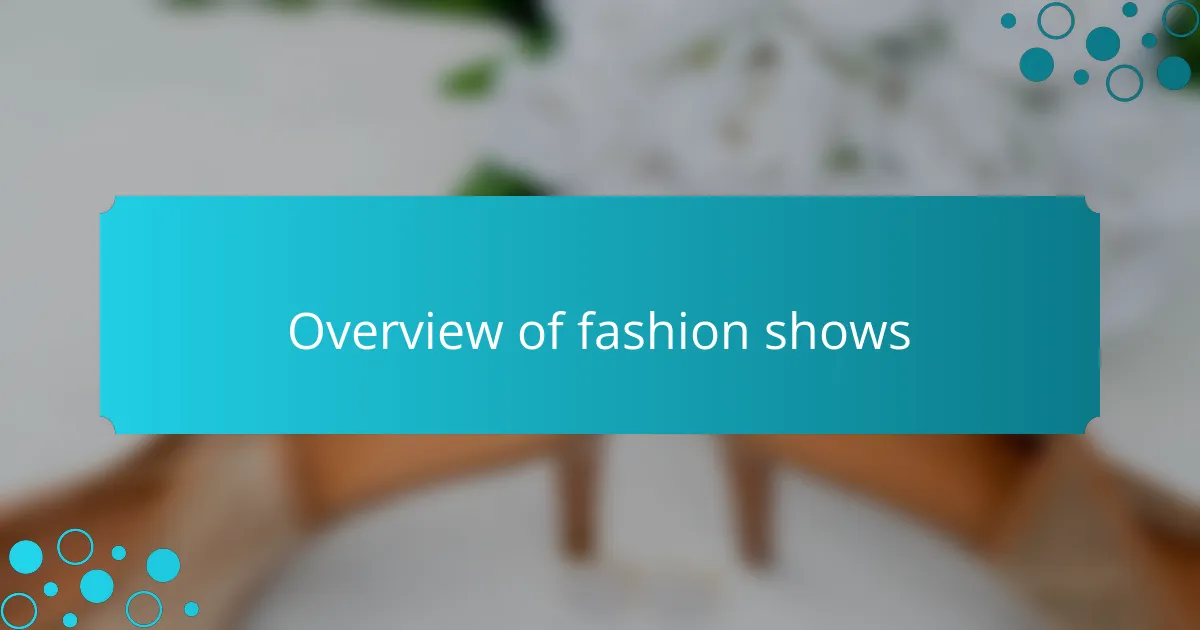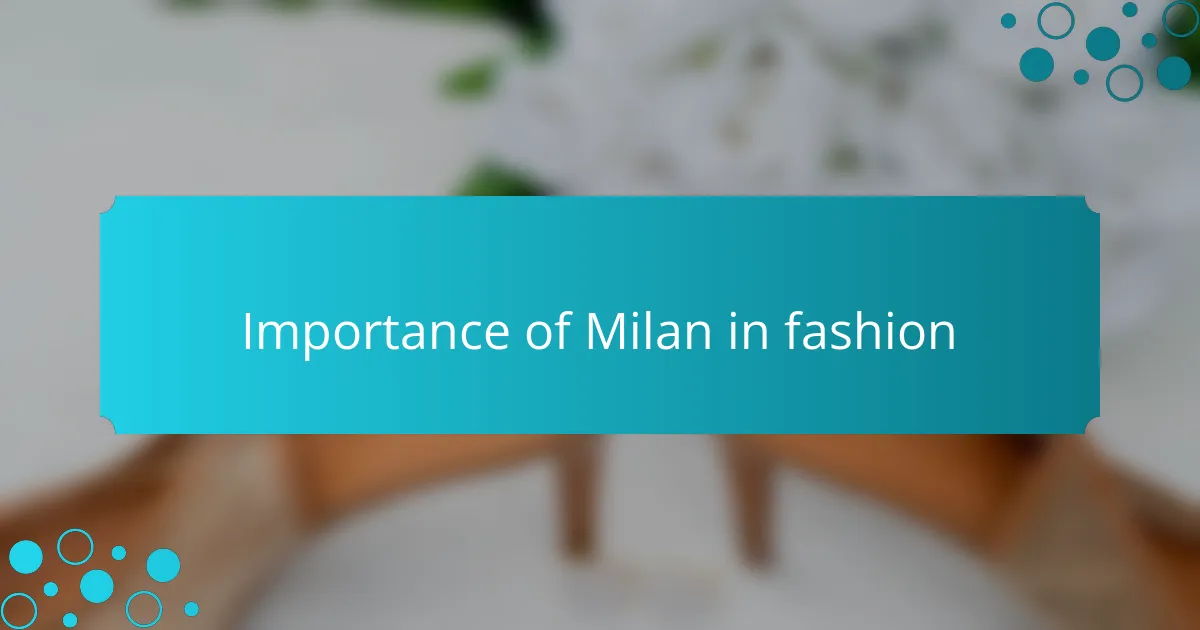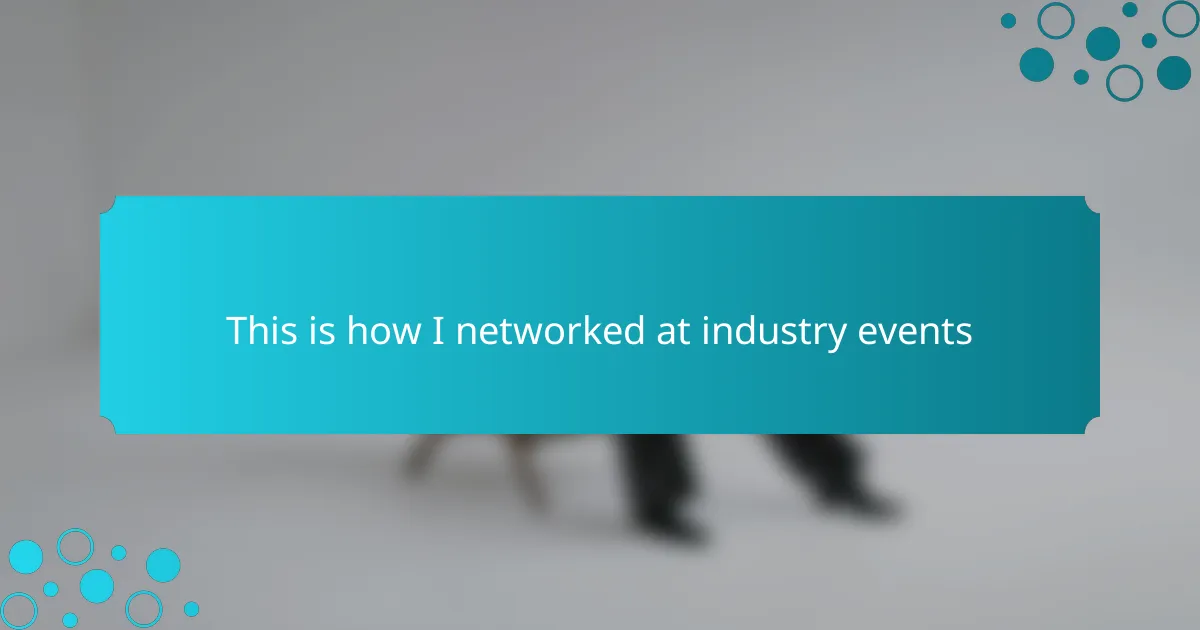Key takeaways
- Fashion shows showcase creativity and innovation, with distinct styles like streetwear and haute couture influencing trends.
- Milan is a pivotal fashion capital, home to luxury brands and important events that connect global talent and foster collaborations.
- Preparation for fashion shows involves fitting, rehearsals, and mental readiness, contributing significantly to a model’s success.
- Collaboration and adaptability are crucial lessons learned from the fast-paced fashion environment during shows in Milan.

Overview of fashion shows
Fashion shows serve as a thrilling showcase of creativity, talent, and innovation in the world of style. Each event reflects the unique vision of designers, offering a glimpse into the trends that will shape the coming seasons. From the pulsating energy of the crowd to the artistry on the runway, my experiences at these shows have left an indelible impression, often making me feel like I’m part of something truly extraordinary.
I’ve had the chance to witness both high-energy streetwear shows and elegant haute couture presentations. Each type of show has its own vibe—one is vibrant and accessible, while the other is both aspirational and dreamlike. It’s fascinating to see how these contrasting styles speak to different aspects of the fashion industry.
Here’s a brief comparison of the two types of fashion shows I’ve encountered:
| Type of Show | Description |
|---|---|
| Streetwear | Casual, urban styles, often featuring cultural influences and accessible fashion. |
| Haute Couture | High-end, handmade creations that embody luxury, craftsmanship, and artistic expression. |

Importance of Milan in fashion
Milan stands as a cornerstone of the fashion world, offering unparalleled exposure to trends and innovations. I remember attending one show where the energy was palpable; the air buzzed with anticipation as designers presented their daring visions. It’s no wonder Milan is often dubbed the fashion capital—each runway tells a story, weaving tradition and modernity together in a mesmerizing tapestry.
Milan’s influence in the fashion industry can be highlighted through several key aspects:
- Global Hub: It attracts designers, models, and fashion enthusiasts from all over the world.
- Fashion Weeks: Events like Milan Fashion Week are pivotal, showcasing top-tier talent and setting trends.
- Luxury Brands: Home to iconic fashion houses such as Prada, Gucci, and Versace, which shape global style narratives.
- Cultural Heritage: The city’s rich history in arts and design enhances its fashion scene, inspiring creativity and innovation.
- Networking Opportunities: It offers a unique platform for industry connections, fostering collaborations and careers.

Key elements of fashion modeling
Fashion modeling isn’t just about showing off clothes; it’s a delicate dance that combines poise, confidence, and presence. During my time in Milan, I quickly learned that each model brings a unique energy to the runway. I remember one show where a model’s subtle smile captivated the audience—this taught me how emotion can elevate a designer’s vision.
Another key element is adaptability. Models must embody various moods and styles, sometimes switching from fierce to playful in the blink of an eye. I found this particularly true at a streetwear show, where the vibe shifted rapidly from edgy to laid-back, reflecting the cultural influences behind the collection. Have you ever noticed how a model’s demeanor can change the way an outfit is perceived? That’s the power of fashion modeling.
Then comes the importance of teamwork. While models are in the spotlight, they are part of a larger picture that includes designers, stylists, and makeup artists. There was a moment backstage when I watched everyone collaborate seamlessly to prepare for the runway. It was a reminder that fashion is as much about collective creativity as it is about individual expression.

Preparing for a fashion show
Preparing for a fashion show is an exhilarating experience, filled with anticipation and a bit of nervous excitement. I remember the night before my first show in Milan, I could hardly sleep. My mind raced with thoughts of the runway, the designers, and how I could truly embody the vision they had for the collection. It was a mixture of thrill and anxiety—emotions that fueled my preparation.
To ensure I was ready to shine on that big day, I focused on several key elements:
- Wardrobe Fitting: Ensured my outfits fit perfectly; there’s nothing like the feel of tailored clothing.
- Hair and Makeup Trials: Scheduled trials with professionals to explore different looks that aligned with the show’s theme.
- Rehearsing Walks: Practiced my runway walk countless times to build confidence and consistency.
- Hydration and Nutrition: Maintained a balanced diet while drinking plenty of water; keeping my energy levels up is essential.
- Mental Preparation: Engaged in mindfulness techniques to calm my nerves and visualize a successful performance.
Every step in the preparation phase is crucial and contributes to the overall success of the show. Each experience teaches valuable lessons, and I always cherish these moments of growth.

My personal fashion show journey
My journey in the world of fashion shows in Milan has been nothing short of transformative. I vividly remember my first show; the thrill of walking down the runway, the bright lights, and the way the audience’s eyes seemed to follow every step. It was both exhilarating and nerve-wracking, but the energy in the air pushed me to embrace the moment fully.
Each show has brought its own lessons and emotions, teaching me about resilience and self-expression. The camaraderie among models backstage is something I cherish—there’s an unspoken bond that forms amidst the hustle and excitement, each of us supporting one another as we chase our dreams together.
Here’s a comparison of my different experiences at Milan fashion shows:
| Show Type | Experience |
|---|---|
| Luxury Brands | High pressure, glamor, and a focus on precision. |
| Emerging Designers | Creative freedom, innovative styles, and a warmer atmosphere. |

Lessons learned from Milan shows
Attending the fashion shows in Milan taught me invaluable lessons about resilience and creativity. I remember standing backstage, surrounded by bustling models and stylists, feeling an electric energy that was contagious. It hit me that success in this industry demands not just talent, but also the ability to adapt under pressure when things don’t go as planned.
Reflecting on those experiences, I realized that the lessons learned extend far beyond the runway:
- Embrace collaboration: Working with diverse talents can spark fresh ideas.
- Stay adaptable: The ability to pivot can make all the difference when faced with last-minute changes.
- Develop a unique voice: Authenticity can set you apart in a competitive environment.
- Network relentlessly: Building relationships can open doors you never knew existed.
- Observe and learn: Pay attention to the details; there’s always something new to glean from each show.
These insights have shaped my approach to fashion and continues to inspire my journey in this beautiful industry.



